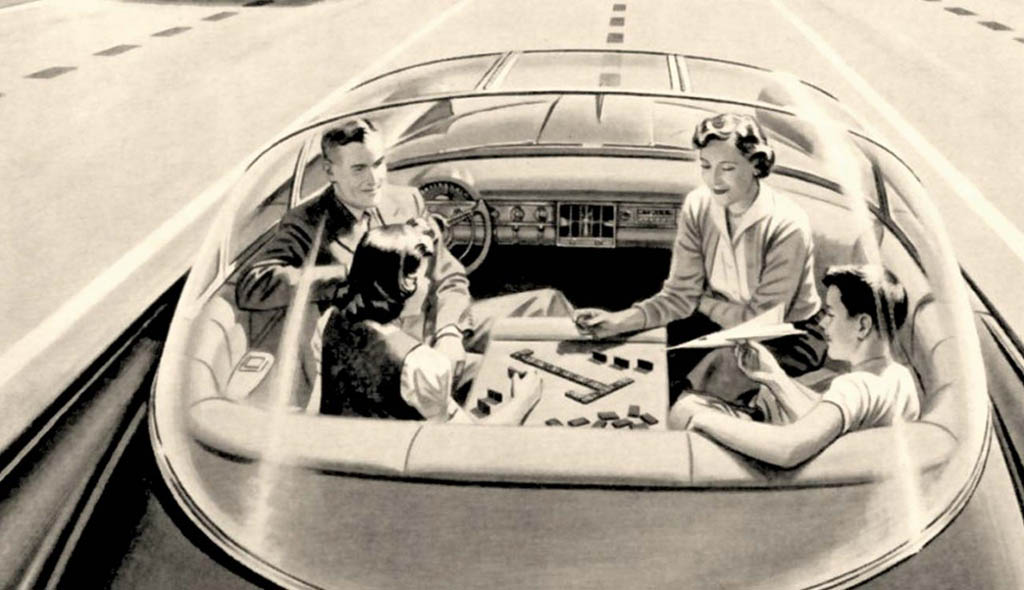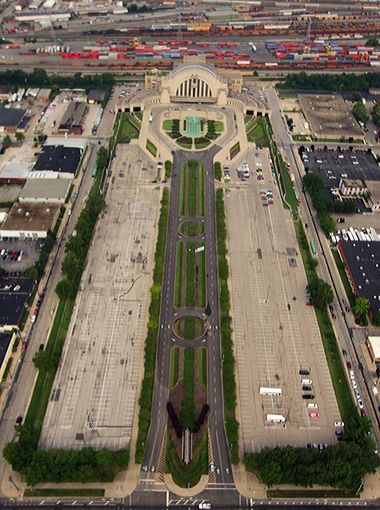
How many people get to your museum by driving their own cars? When they arrive, where do they park? If you are designing a new museum, or a renovation, what parking structures are included in your master plan? I hope today’s post prompts you realize that the answers to all those questions may change radically in the next few decades, due to the rapid rise of self-driving cars.
 |
| We’ve been envisioning driverless cars for decades–see this ad from the 1950s, for example. But now they’ve gone from the realm of fiction to real world use. |
Autonomous vehicles are already on the road in California, Texas, Arizona, Washington, Pennsylvania and Michigan. Last week the US House of Representatives passed the SELF DRIVE Act with bipartisan support. If approved by the Senate, the bill would establish a federal framework for the regulation of self-driving cars in the US, facilitating local experimentation and accelerating adoption. Experts vary on when cars with some degree of autonomy will go mainstream. Credible estimates range from five years to two decades. A recent study by RethinkX forecast that by 2030, self-driving cars could cut car ownership by 80 percent. Any of these estimates lie within the timeline of planning for urban and museum infrastructure.
Cities are already thinking about how to use the bounty of space no longer devoted to parking. According to the research firm Gensler, the US has about 500 million parking spaces to serve 326 million people. Parking infrastructure covers an estimated 3,590 square miles, which as Gensler’s researchers point out, is an area larger than Delaware and Rhode Island combined. What will we do with over two state’s worth of newly available space, much of it in land-hungry urban areas?
Recently over 600 people gathered at the Skirball Center for the Driverless Future Challenge awards. A panel of New York City commissioners bestowed first place on Public Square–Reclaiming the Street, an entry submitted by FXFOWLE with Sam Schwartz Engineering. This concept (illustrated in the video below) proposes a modular system that can be used to convert parking spaces into green spaces, recreation spaces, retail, seating and other uses that suit the needs of particular neighborhoods. The architects describe this “plug-and-play” system as a way of enabling the public realm to be responsive to the ways we drive (or don’t drive) in the future.
What are the implications for our field? I venture to say that the rise of self-driving cars will affect most, if not all our institutions in one way or another. My thinking on the topic is shaped by the fact that two of the museums I worked at, early in my career, inherited freakishly large parking lots from the historic structures they colonized. The Children’s Museum of Dartmouth, MA lived in an old dairy barn and previous owners, who had converted it to a restaurant, paved over a good acre or so for parking. Cincinnati Museum Center moved into that city’s historic train terminal. Take a gander at THIS lot.
 |
| (Cincinnati’s historic Union Terminal, For scale, notice the teeeeeeny cars in the foreground) |
It’s worth spending some time envisioning how a car-free-ish future may change the landscape of your community, your museum’s own campus, and who visits your museum.
- What will you do with the space formerly devoted to cars waiting for their owners’ return? You might follow the lead of the Driverless Future Challenge, and invite your community to help re-envision your space. Think about other transportation trends as well–is your city adopting commercial bikeshare stations? If so, maybe you want to house a docking station on your grounds.
- Do you currently depend on parking fees for part of your income, and what is the net profit, when you factor in the operating costs? You may want to find new use for the space that generates at least enough to cover this lost income.
- How should you take autonomous driving into account in the long term plans for your campus, factoring in the uncertain timeline of adoption for this technology? You might want to focus on surface parking, which is relatively easy to redevelop. (Personally, I like to think that one day Union Terminal’s lots will return to the verdant beauty of the gardens originally occupying this space.) Garages are more expensive to demolish, or convert, but architects are beginning to create parking garages designed to transition to other purposes–such as apartments. Maybe museums can design new parking structures designed to facilitate conversion for other use.
- Driverless cars will increase the mobility of people who don’t or can’t drive–not only Millennials, many of whom already don’t bother to get drivers licenses, but also people with mobility impairments, seniors who have stopped driving for health or safety reasons, and people too young to get a license. Museums may need policies, procedures, and staffing to accommodate unaccompanied children (“hey kids, you’re driving me nuts. Call a car and go to the museum for the afternoon.”) Ditto for visitors young or old with significant cognitive or mobility limitations. We already receive such visitors, of course, but autonomous transportation may amplify their numbers to the point where our response needs to be significantly different as well. Maybe museums will shift some staff displaced by automation over to visitor services, and provide personal escorts for anyone, young or old, who requires personal assistance.
And a further futurist note…
The Driverless Future Challenge was organized by Blank Space–an online platform dedicated to “challenging architecture to rethink its role in society.” I commend Blank Space’s Fairy Tale Challenge to your attention as well. This annual competition solicits short stories and artwork that explore the power of architecture to shape the future. The entries are often surreal, provocative, and inspiring and serve as wonderful illustrations for the Cone of Plausibility encompassing our future cities.








A museum friend forwarded me this article. I'm very pleased to see you calling this issue out. Here is a short 4 minute video that lays out the two future scenarios for self driving cars in our cities https://www.youtube.com/watch?v=UcCD3lXYlTk and the longer associated article if you are interested.
https://backchannel.com/self-driving-cars-will-improve-our-cities-if-they-dont-ruin-them-2dc920345618#.k6moe6awd